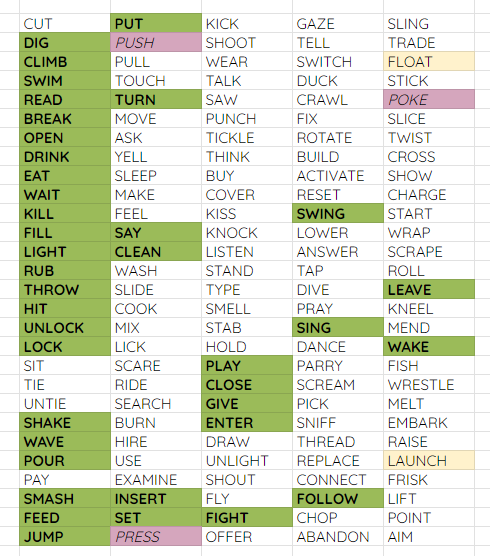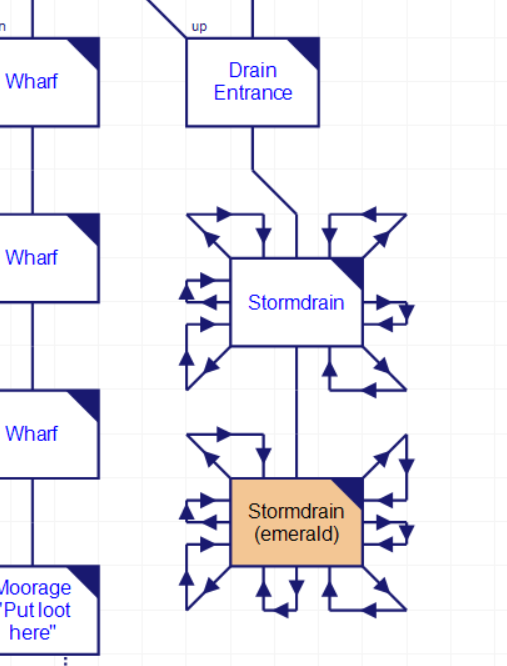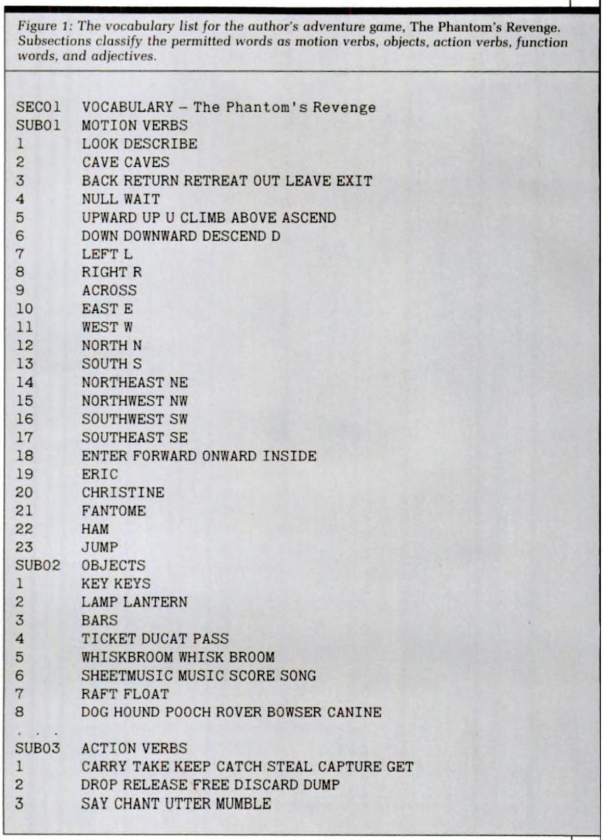I’ve finished the game, and this post assumes you’ve read my previous posts about The Phantom’s Revenge.

Poster from the 1925 film version, still the closest to the book. Via Fandom Wiki.
Breakthrough number one was simply with the parser, regarding the guard dog. PUT LEASH ON COLLAR gave the cryptic message
There isn’t any switch on it.
which I thought meant some dog-slang I didn’t know (I’m a cat person), but after further investigation I realized the game was simply mis-parsing and thinking was hitting an actual light switch or something similar. I ended up just ramming through the entirety of my previously made verb list…

…and hit paydirt with GIVE.
This is a large rectangular room that was used as an office by the prison warden. Obvious exits lead east and north.
A large dog with a spiked collar is sitting here. He looks like he might bite if you annoyed him.
GIVE LEASH TO DOG
The dog growls ominously, but lets you clip the leash to his collar. Once leashed he seems much calmer, even friendly.
This lands the dog and leash in your inventory. The game is still pretty finicky here, as despite the two being described together, there is a difference between dropping the leash and dropping the dog. The dog will you kill you if you DROP DOG normally — that gets interpreted as also unleashing the dog. You need to DROP LEASH instead if you want to drop the dog temporarily, but fortunately for all this you don’t need to bother given the place to unleash the dog is only a few steps away:
E
You are in a small antechamber of some sort. It is simply, but attractively, decorated with nooses and pictures of famous condemned criminals. Passages lead east and west, and there is a doorway in the north wall.
E
You are in a grim looking door-lined hall. To the east is one particularly massive iron-bound door that is ajar. There is a large dark opening to the north.
A nasty looking prison guard is leaning against the cell door, and you hastily draw back, afraid he’ll see you.
DROP DOG
The dog narrows his eyes and snarls, showing ivory-white teeth. Suddenly he realizes he is free, and with a puzzled look he hesitates between you and the guard.
Finally he seems to decide that he hates the guard even more than you, and races toward him! The guard — dense, but no fool – runs like hell, with the dog snapping at his heels!
This is the other side of the starting prison cell, and you can now head north to snag a gold nugget, one of the other treasures.
With the dog out of the way, you can get in the warden’s office, described as a TREASURE TROVE in the room name.
This is the warden’s office.
NThis small square stone room was used to store the warden’s treasures; particularly the things he took away from prisoners. The only exit is a dark doorway that leads south.
This is where the black figure’s stolen loot goes to. (The figure is, as Voltgloss observed from the comments, The Persian, usually cut or merged with other characters for movie versions, although he shows up in the 1925 silent as the Inspector Ledoux.) Just like classic Adventure, after you have items stolen a chest appears with the trove as well, and taking the chest away from the trove causes the theft to stop altogether. On my “final run” I had nearly all my treasures stolen. It was easier than managing the inventory limit, to be honest, and only took to making transfers from the trove back to the wharf (the final deposit place of loot) near the very end. I never considered this as a strategy for original Adventure because the Pirate area in the maze is inconvenient to get to, and the Pirate is less persistent than the Persian is about filching things.
There is a lovely little chest here, full of jewelry.
My next moment of enlightenment was also a little meta. It went back to a portion of the game I thought I had already mapped and resolved, a storm drain with one treasure.

However, when I tried to go back to the area (on another run-through) I got stuck, and despite going north many, many, many times I was not able to get out with the emerald. Given the fact I did nothing special the first time, and none of the items I was carrying seemed to affect the area, I tried again and managed to get out. It simply is random, and the kind of random that one player (me the first time through) might luck through at first, but another player (me on the second) might roll unlucky 25 times in a row. I never worked out the actual percentage chance of escape, but if it’s, say, 10%, that means there’s an 11% chance that you could get unlucky 25 times in a row.
You are in the stormdrain.
NYou are in the stormdrain.
NYou are in the stormdrain.
NYou are in the stormdrain.
NYou are in the stormdrain.
NYou are in the stormdrain.
NYou are in the stormdrain.
NYou are in the stormdrain.
So, going back to the “mazes” I couldn’t get out of as they seemed to be single-room (the Catacombs and the Living Forest), I tested the theory I was just getting unlucky and kept trying to get out. The catacombs follows this theory exactly, so I found a “jeweled idol” and was able to escape the way I came.
There are thousands of strange twisted trees all around you, and oddly dressed people are running back and forth among them. The forest is there wherever you look, endless, frightening.
The Living Forest I was merely able to leave, so I knew I was missing something. I especially knew I was missing something because of this message:
BREAK MIRROR
The Magic Forest is axe-proof, bullet-proof, and maybe even Adventurer-proof. Your attack has no effect.
The mirror isn’t described in the room, but I was clearly presuming right that one was there. I thought to SING (one of the verbs off my list) but no dice:
“The sun shines bright on Pretty Red wing …”
I practice in front of the mirror every morning!
I ended up needing to check hints from Exemptus. There’s some “sheetmusic” I already used to play on an organ and open a secret passage, but apparently it also counts as vocal music if you’re holding it when you sing at the Forest.
It’s a toccata of some sort … “Don Juan Triumphant.”
SING
Your high note shatters the mirrors into a thousand pieces!
WOW, you really HAVE got a voice that shatters glass!LOOK
You are in the Magic Forest.
A litter of broken glass covers the floor. You can see passages leading north, south, and east.
One solitary iron tree stands in the middle of the room.
To the south there’s a “tiny brass cricket” and I admit I had to check hints here again. Despite no indication otherwise you can READ it.
There was engraving on its back, but most of it is worn away. The only readable letters are “-UM-“.
This suggests you can JUMP, which warps you to a room with a ruby, yet another treasure.
You have found a tiny little room painted all in green. Big gold letters on one wall say “JUMP ROOM”. A steep narrow tunnel leads down to the west. If you go down, you will not be able to come back up.
There is a wonderful ruby here, carved to look like a cricket.
My only obstacles that remained were the two types of rats, the little ones and the big one. For the little ones, I hadn’t tried the cheese yet (I tried it on the big rat but just hadn’t gotten around to testing it on the others):
The mice eat the cheese a nibble at a time. They seem a lot friendlier now that they’ve been fed.
This yields a pretty heavy “Russian urn” and you have to be careful because getting back to the opera house requires climbing down a fragile rope ladder, and if you’re carrying too much it breaks.
With that resolved I technically had every single treasure. The big rat doesn’t block anything, the area it leads to you has alternate routes, but I looked up what to do:
A giant rat, easily eight feet high, bares its sharp front teeth, twitches its whiskers, and refuses to let you go by.
kill rat
Oh, sure! By yelling “BOO” I suppose?
yell boo
The giant rat looks startled, shocked, and keels over. I guess the poor thing had a bad heart.
Once the hypothetical came up the answer was easy; I hadn’t thought to KILL RAT. The game otherwise emphasizes the essential uselessness of the verb so it wasn’t at the forefront of my mind.
The theoretical question is a lot easier than Crowther/Woods asking if you are sure you want to engage in fisticuffs with a dragon. You’re still engaging in the parser here in the same way you’ve always done, you don’t have to switch modes and imagine it is possible to interact with the hypothetical narrator. Additionally, for someone who has trouble, the puzzle is genuinely completely optional.

Passing through the room marked in red (with the rat) lets you access the “Southwest Shore”, but there are multiple ways to arrive at the same place, most of them very straightforward.
I still must have missed some kind of puzzle (or maybe I was playing too slow and number of turns matters?) because I didn’t get the full spread of points. After you drop the last treasure at the wharf you just need to wait.
There is a strange idol here, covered with jewels.
(etc, some treasures skipped, you need to drop the white scarf before a jade horse or the jade shatters)
There is a rather dusty — but valuable! — tiara here.
There’s a wonderful little marble statue, signed by someone named “Picasso,” standing here.
There’s a gold nugget, off of a watch fob, here.
There is a delicate white silk scarf here.
A small gold ring lies gleaming on the floor.WAIT
There is a sudden roaring sound as the motor of the launch comes to life. Hurriedly, you cast off the single mooring rope. The launch races off across the sea and finally comes to rest on a lovely, idylic beach. The local inhabitants all crowd around to celebrate your arrival, and proclaim National Adventurer Day, especially in your honor!
Your final score is 321.
You need 14 more points to reach the next higher rating.
You have become a Junior Grandmaster!
I’ve been puzzling over if there’s some sort of real story here with consistent lore, or if the author decided to tag what she thought were neat elements of the Phantom of the Opera story. There certainly seems to be some kind of logic:
- we know from the dive mention of computers that we’re referring to at least the 1970s, 1960s at latest
- there are a number of very ancient things, like a “yellowing program” from the 19th century, that indicates everyone involved ought to be dead
- yet we have someone who appears to be the Persian and a protagonist who is the Phantom
- we also have a single guard who is guarding our protagonist at the start
The timeline suggests that Erik (the Phantom) is too old to be the same Phantom.
There is a strange old prison near here, long abandoned except for a few caretakers, and some half-mad vagrants. A few people say that the prison is haunted by some sort of ghost, and that it guards some fabulous treasure. A lot of people have gone to search the old place, and have never been seen again.
Are we some sort of undead? Like an actual ghost? All previous renditions (that I know of) have Erik be a man, just a deformed one, but I could easily see a different take given we live in a coffin. At least the terror of the old prison and opera house would keep people in the waterfront town from filching the treasure lying around, but I’m unclear if we have been imprisoned a very long time, only to now initiate our revenge, or if this is recent events (why the loss of memory then, though)?
We do get a bonus point if we are holding a photo of Christine when the boat picks us up.
I still thought the lore was effective; unlike Dr. Who Adventure, this leveraged the “fan-fiction shorthand” well to make particular elements much more suggestive than they might otherwise be. I especially liked being able to teleport directly from the location the treasure gets stashed at to the private box reserved for the Ghost.

From the Girard article Do-It-Yourself Adventure. CHRISTINE is listed as a movement verb but I never found out where it gets used.
This was very tightly constrained via the Adventure framework. Dian even mentions in the article above
My own adventure games are built from two basic parts: the driver program and the text files or “script.” The script contains all of the vocabulary words that the driver recognizes, plus the object and place descriptions. There is also a builder program that converts the text in the script to machine-readable tables. Because the games are script-driven. I can build 70 to 80 percent of a new game without ever touching the actual program source code.
which can suggest something like the Scott Adams interpreter, but also suggests to me that the game has to be a treasure hunt and is limited in movable-characters to dwarf and pirate analogues. Still, it’s about the best game this kind of paint-over could attain.
I worry about future games with the same engine branching out, but we need to wait until 1983 anyway until we get there. Coming up next we’ve got two more prison escapes (short ones), two 1982 games written by people who comment on this blog, and finally an incredibly difficult game based on a British TV show where the TV show itself involves playing adventure games.
the Pirate area in the maze is incontinent to get to
I really hope you meant “inconvenient”. 🤣
I’ve sort of used this technique in Zork I sometimes, that is, not worrying much about it if treasures get stolen because you can get them back and it’s fewer things to carry in the meantime.
I did. Incontinent would be the all-different maze.
Zork I makes it pretty easy to transport from the thief-spot to the trophy case, aye.
Speaking of trying to construct a coherent narrative, one thing that’s been puzzling me from the get-go is that we are apparently a prisoner, but our cell door is kept unlocked and even ajar.
I’m willing to let that slide with the assumption that the guard would have to have the same sort of madness as the maniacs throwing knives. I also think that means the confinement has to be recent.
If we push all the time limits really hard it might work — let’s say the Phantom was 20 in 1900, and the events here happen in ’73 (after People’s Computer Company, so the “hacker den” makes sense) — our main character would be in his 90s. We take one last trip back to the cursed opera house intending to “get our revenge”, get captured, and due to our advanced age our getting tossed around causes a bit of memory loss.
Still doesn’t explain The Persian but it could be someone picking up the mantle or whatnot.
Going away from how the neat and clever aspects, the storm drain is unusually cruel even for this era. (though I may have forgotten something) There’s just something about it that made me go, “really?” Another bizarre mechanic for the eventual psycho who makes the evilest adventure game ever made.
I’m glad that you mentioned “fan-fiction shorthand” as an idea, because I think that’s what makes the “twist” work so well. The knowledge of who the Phantom is doesn’t have to be explained in the game, because the player is assumed to already know it – that saves on storage-heavy exposition, whether at the beginning of the game or in the “revelation” room. That way, “You are the Phantom!” is still able to have gravitas, because just four words bring entire other works of media into your mind without having to store them on the disk/tape. It’s almost like a pop-culture allusion but played for drama instead of comedy. I also think that this “justifies” the amnesia plot, insofar that “justifying” means “benefits the plot,” because the revelation is short and punchy instead of segueing into exposition that would burn off the momentum of the… um, moment. It’s so easy to get used to all these games like “Pirate Adventure” or “Magical Adventure” where you just assume that the title is flavoring for the adventure, in the same way that you aren’t supposed to expect “chocolate cereal” to be chocolate, and the pirating or magicking will be few and far between and relegated to NPCs. This game threw me for a loop in a way that other games, such as Ferret, had to wait much, much longer to throw me for. I just think it’s really neat how games like this and Savage Island try to implement more heavy plotting in limited storage space. Savage Island did it through being split into two games and then having a feelie ending, but it’s a wild concept to have the “feelies” for this game be the entire pop-cultural understanding of the Phantom.